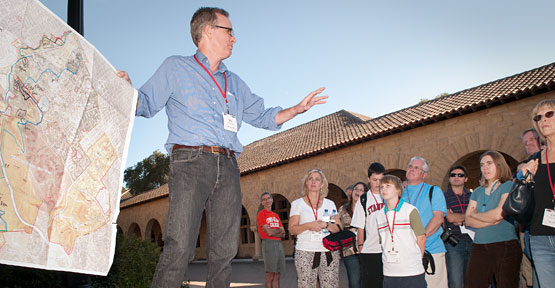About the Bill Lane Center for the American West

The Bill Lane Center for the American West is dedicated to advancing scholarly and public understanding of the past, present, and future of western North America. The center supports research, teaching, and reporting about western land and life in the United States, Canada, and Mexico.
The center’s vision of the West extends from San Francisco Bay to the fabled 100th Meridian, from western Canada to all of Mexico, and outward to the Pacific World.
We work with Stanford students and faculty and partners outside the university to bring their energy, enthusiasm and knowledge to bear on the challenges facing our region. Each year, Stanford offers students more than a hundred courses that touch on the American West in significant ways across dozens of departments and programs from anthropology to history to geological and environmental sciences to public policy. The center is where all of those subjects come together.
Students from a wide variety of disciplines regularly work at the center as research assistants and spend summers on internships from Monterey to Missoula, Yosemite to Yellowstone. These students bring their experiences and enthusiasm back to campus, where the center creates a welcoming home for training, encouraging, and supporting future leaders who care about the region and are eager to put their Stanford education to work in the West.
We do this work in three broad areas:
History and Culture
The Center's founding co-directors, Richard White and David M. Kennedy are leading scholars of American History. Prof. White specializes in three areas central to our mission: western history, environmental history, and Native American history. Under his guidance, the center has become nationally recognized for creating and supporting new research and scholarship on the American West in the humanities and arts.
The Center's founding co-directors, Richard White and David M. Kennedy are leading scholars of American History. Prof. White specializes in three areas central to our mission: western history, environmental history, and Native American history. Under his guidance, the center has become nationally recognized for creating and supporting new research and scholarship on the American West in the humanities and arts.
Environment and Resources
The center works closely with the Woods Institute for the Environment and others at Stanford on crucial environment and resource challenges in the American West. Together, we have embarked on a major long-term initiative on Water in the West. This research and policy program is focusing on making western water systems sustainable. The center also supports research and dialogues with decision makers on emerging challenges and opportunities in conservation, land use planning, energy, and environmental education.
The center works closely with the Woods Institute for the Environment and others at Stanford on crucial environment and resource challenges in the American West. Together, we have embarked on a major long-term initiative on Water in the West. This research and policy program is focusing on making western water systems sustainable. The center also supports research and dialogues with decision makers on emerging challenges and opportunities in conservation, land use planning, energy, and environmental education.
Economy and Public Policy
The center maintains close ties with policymakers and decision makers in the public and private sectors around the American West. These relationships open up opportunities for Stanford students and faculty to engage directly and constructively in finding solutions to the region’s challenges, through research, internships, and dialogues. In partnership with the Stanford Institute for Economic Policy Research (SIEPR), the center co-sponsors an annual State of the West Symposium on the economic and fiscal health of the broad western region that brings students and faculty together with public officials, business, labor, nonprofit leaders, and investors. The center is also engaged in efforts to improve governance at the state, regional and national levels in the West.
The center maintains close ties with policymakers and decision makers in the public and private sectors around the American West. These relationships open up opportunities for Stanford students and faculty to engage directly and constructively in finding solutions to the region’s challenges, through research, internships, and dialogues. In partnership with the Stanford Institute for Economic Policy Research (SIEPR), the center co-sponsors an annual State of the West Symposium on the economic and fiscal health of the broad western region that brings students and faculty together with public officials, business, labor, nonprofit leaders, and investors. The center is also engaged in efforts to improve governance at the state, regional and national levels in the West.
A common thread that links together all of our areas of interest is innovation in digital communication in scholarship, teaching, research, and the media. The Center is deeply engaged in exploring digital mapping, spatial history and analysis, data analysis and visualization, multimedia storytelling, social media, and collaborative research and teaching using new digital tools.


